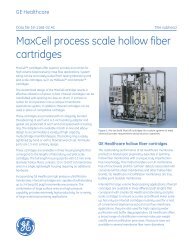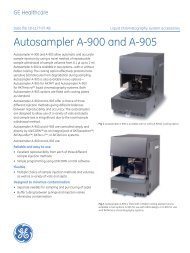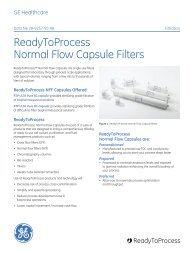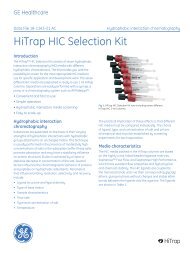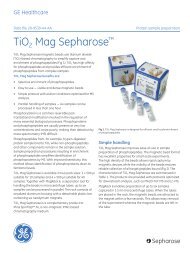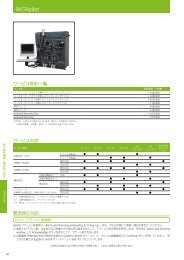[PDF] Data File - rProtein A/Protein G GraviTrap
[PDF] Data File - rProtein A/Protein G GraviTrap
[PDF] Data File - rProtein A/Protein G GraviTrap
Create successful ePaper yourself
Turn your PDF publications into a flip-book with our unique Google optimized e-Paper software.
GE Healthcare<br />
Life Sciences<br />
<strong>Data</strong> file 28-9921-04 AA<br />
<strong>r<strong>Protein</strong></strong> A <strong>GraviTrap</strong> <br />
<strong>Protein</strong> G <strong>GraviTrap</strong><br />
<strong>r<strong>Protein</strong></strong> A/<strong>Protein</strong> G <strong>GraviTrap</strong><br />
<strong>Protein</strong> sample preparation<br />
<strong>r<strong>Protein</strong></strong> A <strong>GraviTrap</strong>, <strong>Protein</strong> G <strong>GraviTrap</strong>, and <strong>r<strong>Protein</strong></strong><br />
A/<strong>Protein</strong> G <strong>GraviTrap</strong> are prepacked gravity-flow columns<br />
designed for fast and efficient manual purification of<br />
monoclonal and polyclonal antibodies, antibody fragments<br />
from cell culture supernatant, and biological fluids. The<br />
antibodies are simply captured with high specificity on<br />
protein A and protein G ligands in gravity-flow columns. You<br />
do not need any other instrument with this protocol because<br />
the entire process relies on the flow of gravity. The yield<br />
varies from 20 to 50 mg of purified antibodies depending on<br />
the ligand you use. The columns are reusable up to five times.<br />
<strong>r<strong>Protein</strong></strong> A <strong>GraviTrap</strong>, <strong>Protein</strong> G <strong>GraviTrap</strong>, and <strong>r<strong>Protein</strong></strong><br />
A/<strong>Protein</strong> G <strong>GraviTrap</strong> deliver:<br />
• Convenience and reliability—prepacked gravity-flow<br />
columns provide convenience, save time, and increase<br />
the reliability of your results<br />
• Speed and simplicity—purification of antibodies in<br />
30 min allows you to quickly obtain and store your target<br />
protein in order to avoid the inherent dangers of protein<br />
instability and degradation associated with slow and long<br />
purification runs<br />
• High purity and recovery—purity > 95% in one step and<br />
recovery typically 70% to 80%<br />
• High binding capacity—<strong>r<strong>Protein</strong></strong> A <strong>GraviTrap</strong> ~ 50 mg<br />
human IgG/column, <strong>Protein</strong> G <strong>GraviTrap</strong> ~ 20 mg human<br />
IgG/column, and <strong>r<strong>Protein</strong></strong> A/<strong>Protein</strong> G <strong>GraviTrap</strong> ~ 35 mg<br />
human IgG/column<br />
The ready-to-use columns are prepacked with 1 ml of<br />
<strong>r<strong>Protein</strong></strong> A Sepharose Fast Flow, <strong>Protein</strong> G Sepharose<br />
4 Fast Flow, and a mixture of 50% <strong>r<strong>Protein</strong></strong> A Sepharose Fast<br />
Flow and 50% <strong>Protein</strong> G Sepharose 4 Fast Flow. The main<br />
characteristics of the columns are described in Table 1.<br />
Fig 1. <strong>r<strong>Protein</strong></strong> A <strong>GraviTrap</strong>, <strong>Protein</strong> G <strong>GraviTrap</strong>, and <strong>r<strong>Protein</strong></strong> A/<strong>Protein</strong><br />
G <strong>GraviTrap</strong> prepacked gravity flow columns provide simple manual<br />
purification of antibodies from cell culture.<br />
Table 1. <strong>r<strong>Protein</strong></strong> A, <strong>Protein</strong> G, and <strong>r<strong>Protein</strong></strong> A/<strong>Protein</strong> G <strong>GraviTrap</strong> column<br />
characteristics<br />
Column material Polypropylene barrel, polyethylene frits<br />
Matrix Highly cross-linked agarose, 4%<br />
Medium<br />
<strong>r<strong>Protein</strong></strong> A Sepharose Fast Flow,<br />
<strong>Protein</strong> G Sepharose 4 Fast Flow or a mixture<br />
of <strong>r<strong>Protein</strong></strong> A Sepharose Fast Flow and <strong>Protein</strong><br />
G Sepharose 4 Fast Flow<br />
Ligand<br />
Bed volume<br />
Binding capacity<br />
Recombinant <strong>Protein</strong> A and <strong>Protein</strong> G<br />
1 ml<br />
Particle size 90 µm<br />
<strong>r<strong>Protein</strong></strong> A Sepharose Fast Flow ~ 50 mg<br />
human IgG /ml medium, <strong>Protein</strong> G Sepharose<br />
4 Fast Flow ~ 20 mg human IgG /ml medium,<br />
<strong>r<strong>Protein</strong></strong> A/<strong>Protein</strong> G Sepharose 4 Fast Flow<br />
~ 35 mg human IgG /ml medium<br />
imagination at work<br />
Working temperature<br />
Storage solution<br />
Storage temperature<br />
Room temperature<br />
20% ethanol<br />
+2°C to +8°C
Antibody binding to <strong>Protein</strong> A and<br />
<strong>Protein</strong> G<br />
The binding strengths of protein A and protein G for<br />
immunoglobulins (IgG) depend on the source species and<br />
subclass of the particular immunoglobulin (Table 2). You<br />
may begin with <strong>r<strong>Protein</strong></strong> A/<strong>Protein</strong> G <strong>GraviTrap</strong> if the binding<br />
strength of the target immunoglobulin is unknown.<br />
IgG elution occurs by lowering the pH. Different immunoglobulins<br />
elute at different pH values depending on the<br />
subclass and the species from which they originate. We<br />
recommend that you add neutralizing buffer to the column<br />
eluate in order to preserve the activity of acid-labile IgGs.<br />
Table 2. Relative binding strengths for protein A and protein G<br />
Species Subclass <strong>Protein</strong> A<br />
binding<br />
<strong>Protein</strong> G<br />
binding<br />
Human IgA variable -<br />
IgD - -<br />
IgD - -<br />
IgG 1 ++++ ++++<br />
IgG 2 ++++ ++++<br />
IgG 3 - ++++<br />
IgG 4 ++++ ++++<br />
IgM variable -<br />
Avian egg yolk IgY - -<br />
Cow ++ ++++<br />
Dog ++ +<br />
Goat - ++<br />
Guinea Pig IgG 1 ++++ ++<br />
IgG 2 ++++ ++<br />
Hamster + ++<br />
Horse ++ ++++<br />
Koala - +<br />
Llama - +<br />
Monkey (rhesus) ++++ ++++<br />
Mouse IgG 1 + ++++<br />
IgG 2a ++++ ++++<br />
IgG 2b +++ +++<br />
IgG 3 ++ +++<br />
IgM variable -<br />
Pig +++ +++<br />
Rabbit ++++ +++<br />
Rat IgG 1 - +<br />
IgG 2a - ++++<br />
IgG 2b - ++<br />
IgG 3 - ++<br />
Sheep +/- ++<br />
++++ = strong binding, ++ = medium binding, - = weak or no binding<br />
Simple purification of antibodies in 30 min<br />
The purification of immunoglobulins with <strong>r<strong>Protein</strong></strong> A<br />
<strong>GraviTrap</strong>, <strong>Protein</strong> G <strong>GraviTrap</strong>, and <strong>r<strong>Protein</strong></strong> A/<strong>Protein</strong> G<br />
<strong>GraviTrap</strong> comprises equilibration, sample application,<br />
washing and elution steps (Fig 2). The duration of a single<br />
purification run is about 30 min (depending on the volume<br />
and the viscosity of your sample). You can perform antibody<br />
purifications with a wide choice of buffers because <strong>r<strong>Protein</strong></strong><br />
A <strong>GraviTrap</strong>, <strong>Protein</strong> G <strong>GraviTrap</strong>, and <strong>r<strong>Protein</strong></strong> A/<strong>Protein</strong> G<br />
<strong>GraviTrap</strong> have high affinities for a broad range of immunoglobulins<br />
at about pH 7.0. To attain effective binding, the pH<br />
of your sample should be the same as that of the binding<br />
buffer prior to sample application.<br />
Equilibrate Load Sample Wash Elute<br />
Fig 2. A fast and simple four-stage process for purifying immunoglobulins on<br />
<strong>r<strong>Protein</strong></strong> A <strong>GraviTrap</strong>, <strong>Protein</strong> G <strong>GraviTrap</strong>, and <strong>r<strong>Protein</strong></strong> A/<strong>Protein</strong> G <strong>GraviTrap</strong><br />
columns.<br />
Complementary products provide speed<br />
and convenience<br />
The use of complementary products like Workmate,<br />
LabMate, and Ab Buffer Kit with <strong>r<strong>Protein</strong></strong> A <strong>GraviTrap</strong>,<br />
<strong>Protein</strong> G <strong>GraviTrap</strong>, and <strong>r<strong>Protein</strong></strong> A/<strong>Protein</strong> G <strong>GraviTrap</strong><br />
columns further enhances the versatility of the gravity-flow<br />
antibody purification method described in this data file<br />
(Fig 3).<br />
Workmate and LabMate<br />
We provide <strong>r<strong>Protein</strong></strong> A <strong>GraviTrap</strong>, <strong>Protein</strong> G <strong>GraviTrap</strong>, and<br />
<strong>r<strong>Protein</strong></strong> A/<strong>Protein</strong> G <strong>GraviTrap</strong> columns in a format that<br />
you can convert into a column stand (Workmate). The<br />
plastic tray in the package can be used to collect liquid<br />
waste. If you need to work with a sample volume that is ><br />
10 ml, connecting a LabMate buffer reservoir to the column<br />
increases the loading capacity to about 35 ml.<br />
Ab Buffer Kit<br />
You can eliminate the tedious step of buffer preparation<br />
when you use the Ab Buffer Kit with <strong>r<strong>Protein</strong></strong> A <strong>GraviTrap</strong>,<br />
<strong>Protein</strong> G <strong>GraviTrap</strong> or <strong>r<strong>Protein</strong></strong> A/<strong>Protein</strong> G <strong>GraviTrap</strong><br />
columns. The kit contains optimized buffers for each step<br />
(binding, elution, and neutralizing) of the purification of<br />
monoclonal and polyclonal IgG.<br />
28-9921-04 AA 2
High repeatability of IgG purifications<br />
We carried out a repeatability study by performing six<br />
replicate runs on each type of column (i.e., six each of<br />
<strong>r<strong>Protein</strong></strong> A <strong>GraviTrap</strong>, <strong>Protein</strong> G <strong>GraviTrap</strong>, and <strong>r<strong>Protein</strong></strong> A<br />
<strong>GraviTrap</strong>/ <strong>Protein</strong> G <strong>GraviTrap</strong> columns). The IgG recovery,<br />
calculated by absorbance measurements and extinction<br />
coefficient, was 72% to 84% depending on column type.<br />
Fig 3. Workmate, LabMate, and Ab Buffer Kit complement <strong>r<strong>Protein</strong></strong> A<br />
<strong>GraviTrap</strong>, <strong>Protein</strong> G <strong>GraviTrap</strong>, and <strong>r<strong>Protein</strong></strong> A/<strong>Protein</strong> G <strong>GraviTrap</strong> columns,<br />
thus adding flexibility and versatility to the gravity-flow antibody purification<br />
method.<br />
Reusability of <strong>GraviTrap</strong> columns<br />
You can reuse the same <strong>GraviTrap</strong> column to purify the<br />
same antibody up to 5 times consecutively without having<br />
any adverse effect on the performance of the column. We<br />
performed five consecutive purification runs on three <strong>Protein</strong><br />
G <strong>GraviTrap</strong> columns (Table 3) in order to test the reusability<br />
of the column. The IgG recovery was > 78% for all purification<br />
cycles (Fig 4), and IgG purity was > 95% based on SDS<br />
gel electrophoresis and analysis with ImageQuant TL<br />
software (data not shown).<br />
Table 3. Experimental conditions for <strong>Protein</strong> G <strong>GraviTrap</strong> reusability study<br />
Table 4. Experimental conditions for a repeatability study on <strong>r<strong>Protein</strong></strong> A<br />
<strong>GraviTrap</strong>, <strong>Protein</strong> G <strong>GraviTrap</strong>, and <strong>r<strong>Protein</strong></strong> A <strong>GraviTrap</strong>/<strong>Protein</strong> G <strong>GraviTrap</strong><br />
columns<br />
Columns/media<br />
Sample<br />
Sample load<br />
<strong>r<strong>Protein</strong></strong> A <strong>GraviTrap</strong><br />
<strong>Protein</strong> G <strong>GraviTrap</strong><br />
<strong>r<strong>Protein</strong></strong> A <strong>GraviTrap</strong>/<strong>Protein</strong> G <strong>GraviTrap</strong><br />
Human IgG spiked in E. coli lysate<br />
50% of theoretical binding capacity<br />
Binding/wash buffer 20 mM sodium phosphate, pH 7.0<br />
Elution buffer 0.1 M glycine-HCl, pH 2.7<br />
The results (Fig 5) show that the purification runs were highly<br />
repeatable with a relative standard deviation (RSD) of < 2%<br />
for the IgG recovery in all cases.<br />
85.0<br />
Columns/media<br />
<strong>Protein</strong> G <strong>GraviTrap</strong><br />
80.0<br />
Sample<br />
Human IgG spiked in E. coli lysate<br />
Sample load<br />
50% of theoretical binding capacity<br />
Binding/wash buffer 20 mM sodium phosphate, pH 7.0<br />
Elution buffer 0.1 M glycine-HCl, pH 2.7<br />
Recovery (%)<br />
75.0<br />
70.0<br />
65.0<br />
IgG Recovery (%)<br />
100<br />
90<br />
80<br />
70<br />
60<br />
50<br />
40<br />
30<br />
20<br />
10<br />
0<br />
Column 1<br />
Column 2<br />
Column 3<br />
Column 1<br />
Column 2<br />
Column 3<br />
Column 1<br />
Column 2<br />
Column 3<br />
Column 1<br />
Column 2<br />
Column 3<br />
Column 1<br />
Column 2<br />
Column 3<br />
Cycle 1 Cycle 2 Cycle 3 Cycle 4 Cycle 5<br />
Fig 4. Five consecutive purification<br />
Purification<br />
cycles on<br />
cycle<br />
a <strong>Protein</strong> G <strong>GraviTrap</strong> column<br />
produced similar IgG recovery thus showing that the columns are highly<br />
reliable and reusable.<br />
60.0<br />
<strong>r<strong>Protein</strong></strong> A Gravitrap <strong>Protein</strong> G Gravitrap <strong>r<strong>Protein</strong></strong> A/<strong>Protein</strong> G Gravitrap<br />
Fig 5. Six replicate runs on <strong>r<strong>Protein</strong></strong> A Gravitrap, <strong>Protein</strong> G <strong>GraviTrap</strong>, and<br />
<strong>r<strong>Protein</strong></strong> A/<strong>Protein</strong> G Gravitrap columns show that the purification runs were<br />
highly repeatable. The relative standard deviation (RSD) for the IgG recovery<br />
was < 2% for all column types. Y-error bars represent the standard error.<br />
Note that the values of the y-axis range from 60% to 85%.<br />
Applications<br />
Comparative purification of human monoclonal<br />
antibodies (MAb) with two different columns<br />
In a comparative study, we used two <strong>r<strong>Protein</strong></strong> A/<strong>Protein</strong><br />
G <strong>GraviTrap</strong> and two Pierce <strong>Protein</strong> A/G Plus Agarose<br />
columns to purify human monoclonal antibodies from<br />
Chinese Hamster Ovary (CHO) cell cultivation media (Table 5).<br />
We determined the recovery and purity for each purification<br />
cycle with each of the columns. The purification runs were<br />
performed at the laboratories of GE Healthcare Life Sciences<br />
according to the instructions supplied with each column.<br />
28-9921-04 AA 3
Table 5. Experimental conditions for human monoclonal antibody<br />
purification<br />
80<br />
70<br />
Supplier GE Healthcare Thermo Scientific<br />
Columns/media<br />
Binding capacity<br />
Sample load<br />
<strong>r<strong>Protein</strong></strong> A/<strong>Protein</strong> G<br />
<strong>GraviTrap</strong><br />
~ 35 mg human<br />
IgG/ml medium<br />
70% of theoretical<br />
binding capacity<br />
<strong>Protein</strong> A/G Plus<br />
Agarose<br />
> 50 mg human<br />
IgG/ml medium<br />
70% of theoretical<br />
binding capacity<br />
Recovery (%)<br />
60<br />
50<br />
40<br />
30<br />
20<br />
10<br />
Binding/wash buffer<br />
20 mM sodium<br />
phosphate, pH 7.0<br />
<strong>Protein</strong> A/G Binding<br />
Buffer, Prod # 54200<br />
(Thermo Scientific)<br />
0<br />
Column 1 Column 2 Column 1 Column 2<br />
<strong>r<strong>Protein</strong></strong> A/<strong>Protein</strong> G Gravitrap<br />
Pierce <strong>Protein</strong> A/G Plus<br />
Elution buffer<br />
0.1 M glycine-HCl,<br />
pH 2.7<br />
0.1 M glycine-HCl,<br />
pH 2.7<br />
Fig 7. Recovery of human monoclonal antibody on <strong>r<strong>Protein</strong></strong> A/<strong>Protein</strong> G<br />
<strong>GraviTrap</strong> and Pierce <strong>Protein</strong> A/G Plus columns.<br />
Simplicity and speed are very important factors in the use<br />
of gravity columns to purify antibodies because of the risk<br />
of protein instability and degradation. In this comparative<br />
study, the total purification time for the <strong>r<strong>Protein</strong></strong> A/<strong>Protein</strong> G<br />
<strong>GraviTrap</strong> column was 26 min while that of the Pierce <strong>Protein</strong><br />
A/G Plus A was 84 min. Thus the duration of the <strong>r<strong>Protein</strong></strong><br />
A/<strong>Protein</strong> G <strong>GraviTrap</strong> column was more than three times<br />
faster than that of Pierce <strong>Protein</strong> A/G Plus A.<br />
Average<br />
<strong>r<strong>Protein</strong></strong> A<br />
/<strong>Protein</strong> G<br />
Gravitrap<br />
Time (min)<br />
Average<br />
Pierce<br />
<strong>Protein</strong> A/G<br />
Time (min)<br />
Equilibration Sample load Wash Elution Total time<br />
26 min<br />
84 min<br />
Fig 6. Average duration of protein purification cycles (two columns of each<br />
type) on <strong>r<strong>Protein</strong></strong> A/<strong>Protein</strong> G <strong>GraviTrap</strong> and Pierce <strong>Protein</strong> A/G Plus Agarose<br />
columns. The speed of an antibody purification cycle with <strong>r<strong>Protein</strong></strong> A/<strong>Protein</strong><br />
G <strong>GraviTrap</strong> columns was more than three times faster than that of Pierce<br />
<strong>Protein</strong> A/G Plus Agarose columns.<br />
In the use of gravity columns to purify antibodies, speed and<br />
simplicity cannot be attained at the expense of other crucial<br />
factors such as degree of recovery and purity. <strong>r<strong>Protein</strong></strong><br />
A/<strong>Protein</strong> G <strong>GraviTrap</strong> column produced significantly higher<br />
sample recovery than the corresponding <strong>Protein</strong> A/G Plus<br />
columns from Pierce (Fig 7).<br />
Determination of MAb recovery via absorbance measurements<br />
and extinction coefficient was 67% with the <strong>r<strong>Protein</strong></strong><br />
A/<strong>Protein</strong> G <strong>GraviTrap</strong> columns, and 53% with the Pierce<br />
<strong>Protein</strong> A/G Plus columns. <strong>Protein</strong> pattern and purity were<br />
checked by SDS gel electrophoresis with Deep Purple<br />
Total <strong>Protein</strong> Stain (Fig 8).<br />
M r<br />
× 10 3<br />
97.0<br />
66.0<br />
45.0<br />
30.0<br />
20.1<br />
14.4<br />
Low molecular weight marker<br />
Start material (diluted 1:20)<br />
<strong>r<strong>Protein</strong></strong> A/<strong>Protein</strong> G <strong>GraviTrap</strong> wash<br />
<strong>r<strong>Protein</strong></strong> A/<strong>Protein</strong> G <strong>GraviTrap</strong> wash<br />
<strong>r<strong>Protein</strong></strong> A/<strong>Protein</strong> G <strong>GraviTrap</strong> eluate (diluted 1:5)<br />
<strong>r<strong>Protein</strong></strong> A/<strong>Protein</strong> G <strong>GraviTrap</strong> eluate (diluted 1:5)<br />
Start material (diluted 1:10)<br />
Pierce <strong>Protein</strong> A/G Plus wash<br />
Pierce <strong>Protein</strong> A/G Plus wash<br />
Pierce <strong>Protein</strong> A/G Plus eluate (diluted 1:5)<br />
Pierce <strong>Protein</strong> A/G Plus eluate (diluted 1:5)<br />
1 2 3 4 5 6 7 8 9 10 11<br />
Fig 8. SDS-PAGE stained with Deep Purple Total <strong>Protein</strong> Stain (under reducing<br />
conditions) of fractions from the human monoclonal antibody purification on<br />
<strong>r<strong>Protein</strong></strong> A/<strong>Protein</strong> G <strong>GraviTrap</strong> and Pierce <strong>Protein</strong> A/G Plus Agarose columns.<br />
28-9921-04 AA 4
Comparative purification of rabbit serum<br />
IgG with 2 different columns<br />
In another comparative study performed at the laboratories<br />
of GE Healthcare, we used 2 <strong>r<strong>Protein</strong></strong> A <strong>GraviTrap</strong> and<br />
2 Econo-Pac <strong>Protein</strong> A Affi-Gel columns from Bio-Rad<br />
to purify rabbit serum IgG (anti-goat) according to their<br />
manufacturers’ instructions. The experimental conditions<br />
are summarized in Table 6.<br />
Despite the larger gel volume of the Bio-Rad Econo-Pac<br />
<strong>Protein</strong> A columns, Figure 10 shows that the binding capacity<br />
of <strong>r<strong>Protein</strong></strong> A <strong>GraviTrap</strong> and Bio-Rad Econo-Pac <strong>Protein</strong> A<br />
Affi-Gel columns were similar. About 11 mg of purified rabbit<br />
IgG was obtained on each column in a single purification run.<br />
13.0<br />
11.0<br />
Table 6. Experimental conditions for purification of rabbit serum IgG<br />
Supplier GE Healthcare Bio-Rad<br />
Columns/media<br />
<strong>r<strong>Protein</strong></strong> A<br />
<strong>GraviTrap</strong><br />
Econo-Pac <strong>Protein</strong> A Affi-Gel<br />
IgG yield (mg)<br />
9.0<br />
7.0<br />
Sample load<br />
Binding/wash<br />
buffer<br />
Elution buffer<br />
2 ml rabbit serum<br />
(diluted 1:1 with<br />
binding buffer)<br />
20 mM sodium<br />
phosphate, pH<br />
7.0<br />
0,1 M glycine-<br />
HCl, pH 2.7<br />
2 ml rabbit serum (diluted 1:1 with<br />
binding buffer)<br />
Affi-Gel <strong>Protein</strong> A MAPSII Binding<br />
Buffer (Kit #732-2020)<br />
Affi-Gel <strong>Protein</strong> A MAPSII Elution<br />
Buffer (Kit #732-2020)<br />
5.0<br />
Column 1 Column 2 Column 1 Column 2<br />
<strong>r<strong>Protein</strong></strong> A Gravitrap<br />
Bio-Rad Econo-Pac<br />
<strong>Protein</strong> A Affi-Gel<br />
Fig 10. Purification of rabbit IgG on <strong>r<strong>Protein</strong></strong> A <strong>GraviTrap</strong> and Bio-Rad<br />
Econo-Pac <strong>Protein</strong> A Affi-Gel columns. Each bar represents the amount of<br />
purified IgG from each column in a single purification run. We noticed a<br />
difference in binding capacity between the two Bio-Rad Econo-Pac <strong>Protein</strong><br />
A columns.<br />
Figure 9 shows the average duration of each individual<br />
purification step as well as the total purification time. The<br />
results show that the <strong>r<strong>Protein</strong></strong> A <strong>GraviTrap</strong> column was more<br />
than three times faster than the Econo-Pac <strong>Protein</strong> A Affi-Gel.<br />
Average<br />
<strong>r<strong>Protein</strong></strong><br />
A <strong>GraviTrap</strong><br />
Time (min)<br />
Average<br />
<strong>r<strong>Protein</strong></strong><br />
A <strong>GraviTrap</strong><br />
Time (min)<br />
Equilibration Sample load Wash Elution Total time<br />
21 min<br />
73 min<br />
Fig 9. Average duration of protein purification cycles (2 columns of each<br />
type) on <strong>r<strong>Protein</strong></strong> A <strong>GraviTrap</strong> and Bio-Rad Econo-Pac <strong>Protein</strong> A Affi-Gel<br />
columns. The speed of an antibody purification cycle with <strong>r<strong>Protein</strong></strong> A<br />
columns was more than three times faster than that of Bio-Rad Econo-Pac<br />
<strong>Protein</strong> A Affi-Gel columns.<br />
<strong>Protein</strong> pattern and purity were checked via SDS gel electrophoresis<br />
stained with Deep Purple Total <strong>Protein</strong> Stain (Fig 11).<br />
M r × 10 3<br />
97.0<br />
66.0<br />
45.0<br />
30.0<br />
20.1<br />
14.4<br />
Low molecular weight marker<br />
<strong>r<strong>Protein</strong></strong> A <strong>GraviTrap</strong> wash<br />
<strong>r<strong>Protein</strong></strong> A <strong>GraviTrap</strong> elution (diluted 1:1)<br />
Bio-Rad <strong>Protein</strong> A wash<br />
Bio-Rad <strong>Protein</strong> A eluate<br />
1 2 3 4 5<br />
Fig 11. SDS-PAGE stained with Deep Purple Total <strong>Protein</strong> Stain (under<br />
reducing conditions) of eluted fractions from purification of rabbit IgG on<br />
<strong>r<strong>Protein</strong></strong> A <strong>GraviTrap</strong> and Bio-Rad Econo-Pac <strong>Protein</strong> A Affi-Gel columns.<br />
28-9921-04 AA 5
Ordering information<br />
Products Quantity Code No.<br />
<strong>r<strong>Protein</strong></strong> A <strong>GraviTrap</strong> 10 × 1 ml 28-9852-54<br />
<strong>Protein</strong> G <strong>GraviTrap</strong> 10 × 1 ml 28-9852-55<br />
<strong>r<strong>Protein</strong></strong> A/<strong>Protein</strong> G <strong>GraviTrap</strong> 10 × 1 ml 28-9852-56<br />
Related products Quantity Code No.<br />
Ab Buffer Kit 1 28-9030-59<br />
LabMate PD-10 Buffer Reservoir 10 reservoirs 18-3216-03<br />
Disposable PD-10 Desalting Columns 30 columns 17-0851-01<br />
HiTrap Desalting 5× 5 ml 5 columns 17-1408-01<br />
For your local office contact information, visit<br />
www.gelifesciences.com/contact<br />
GE Healthcare Bio-Sciences AB<br />
Björkgatan 30<br />
751 84 Uppsala<br />
Sweden<br />
www.gelifesciences.com/sampleprep<br />
imagination at work<br />
GE, imagination at work, and GE monogram are trademarks of General Electric Company.<br />
Deep Purple, ImageQuant, LabMate, and Sepharose are trademarks of GE Healthcare companies.<br />
Pierce is a trademark of Thermo Scientific. Bio-Rad, Econo-Pac and Affi-Gel are trademarks of Bio-Rad<br />
Laboratories, Inc.<br />
Deep Purple Total <strong>Protein</strong> Stain: Deep Purple Total <strong>Protein</strong> Stain is exclusively licensed to GE Healthcare from<br />
Fluorotechnics Pty Ltd. Deep Purple Total <strong>Protein</strong> Stain may only be used for applications in life science research.<br />
Deep Purple is covered under a granted patent in New Zealand entitled “Fluorescent Compounds”, patent<br />
number 522291 and equivalent patents and patent applications in other countries.<br />
© 2011 General Electric Company—All rights reserved.<br />
First published Mar 2011.<br />
All goods and services are sold subject to the terms and conditions of sale of the company within GE Healthcare<br />
which supplies them. A copy of these terms and conditions is available on request.<br />
Contact your local GE Healthcare representative for the most current information.<br />
GE Healthcare UK Ltd, Amersham Place<br />
Little Chalfont, Buckinghamshire, HP7 9NA<br />
UK<br />
GE Healthcare Bio-Sciences Corp<br />
800 Centennial Avenue, P.O. Box 1327, Piscataway, NJ 08855-1327<br />
USA<br />
GE Healthcare Europe GmbH<br />
Munzinger Strasse 5, D-79111 Freiburg,<br />
Germany<br />
GE Healthcare Japan Corporation<br />
Sanken Bldg., 3-25-1, Hyakunincho, Shinjuku-ku, Tokyo 169-0073<br />
Japan<br />
28-9921-04 AA 03/2011


![[PDF] Data File - rProtein A/Protein G GraviTrap](https://img.yumpu.com/21539052/1/500x640/pdf-data-file-rprotein-a-protein-g-gravitrap.jpg)
![[PDF] マニュアル GradiFrac](https://img.yumpu.com/22037825/1/190x253/pdf-gradifrac.jpg?quality=85)
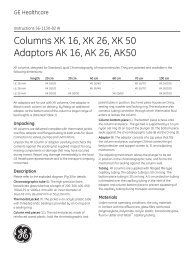
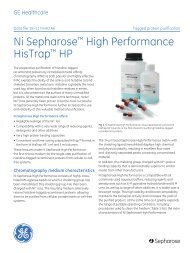
![[PDF] Sample preparation for analysis of protein, peptides and ...](https://img.yumpu.com/21549715/1/190x257/pdf-sample-preparation-for-analysis-of-protein-peptides-and-.jpg?quality=85)
![[PDF] Data File: rProtein A Sepharose Fast Flow](https://img.yumpu.com/21549316/1/190x253/pdf-data-file-rprotein-a-sepharose-fast-flow.jpg?quality=85)
![[PDF] MBP-tagged protein purification](https://img.yumpu.com/21548507/1/184x260/pdf-mbp-tagged-protein-purification.jpg?quality=85)
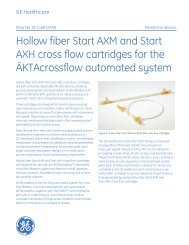
![[PDF] AKTA ready system Data file](https://img.yumpu.com/21540925/1/190x253/pdf-akta-ready-system-data-file.jpg?quality=85)
